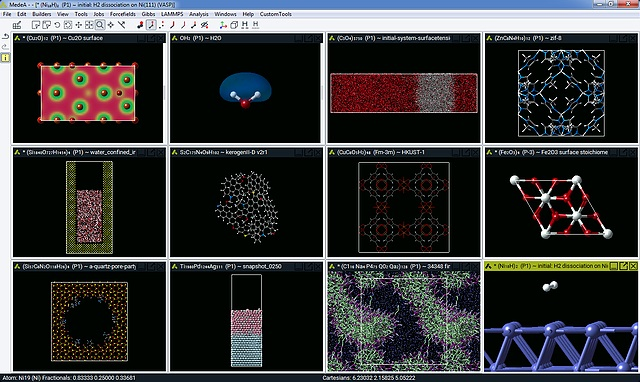The MedeA 3.1 release provides cutting edge functionality including VASP 6 support and mesoscale simulation tools.

A wide range of new capabilities have been added to MedeA, including:
- VASP 6 with a dedicated GUI
- A mesoscale builder for creation of coarse-grained molecules
- Extensions to builders for handling coarse-grained systems (polymer builder, amorphous materials builder and thermoset builder)
- Flowchart support for mechanical modification of arbitrary systems through the Deformation module
- The direct simulation of emissivity
- The ability to start GIBBS Monte Carlo simulations from existing configurations
- Numerous PCFF+ forcefield enhancements
- Support for the latest version of LAMMPS
- A streamlined installation and administration interface
- The UNIFAC correlative simulation method
- A diverse array of high throughput simulation environment updates
- Numerous enhancements throughout MedeA's infrastructure support the key themes of this release: accuracy and realism
MedeA is the leading environment for materials design, modeling, and simulation for the Windows and Linux software platforms, designed and engineered to provide access to high quality simulation methods.
"MedeA 3.1 is a substantial new release of the MedeA Environment." said Dr. Marianna Yiannourakou of Materials Design. "Our development, support, and contract research teams worked closely with customers to select the features and enhancements that comprise this release and on testing and validation. VASP 6 provides efficient access to state-of-the-art accuracy of first-principles methods and with building, simulation, and analysis capabilities for mesoscale systems, MedeA facilitates simulations at any desired level of system scale. With a wide range of infrastructural enhancements, this release has been a true delight for us to assemble as a team and we already see that it provides substantial value for users. If you would like to learn more about MedeA, or Materials Design, please do not hesitate to get in touch."
Description of MedeA 3.1 new features and enhancements
Builders and Editors
- Mesoscale Builder: NEW builder for building coarse-grained molecules, using pre-defined beads or introducing new types of beads
- Polymer Builder: ability to build coarse-grained polymers
- Amorphous Builder: ability to build coarse-grained systems
- Thermoset Builder: ability to build coarse-grained thermosets
Engines
-
MedeA VASP
- VASP 5.4.4 and VASP 6.1.1 executables
- Dedicated VASP 6 GUI enabling easy access to newly implemented functionality of VASP 6.1.1 as listed below
- Space-time based approach for the calculation of polarizibility, providing essentially cubic rather than quartic scaling with system size, facilitating the study of larger systems
- Accurate energy, forces and phonon modes from adiabatic connection applying the space-time algorithm (Low Scaling ACFDT/RPA)
- Automatic optimization of atom position on the ACFDT/RPA level of theory applying the space-time algorithm
- Accurate energy from Moeller-Plesset perturbation theory (MP2)
- Dielectric-dependent hybrid functionals (DDH/DSH)
- Electron-phonon interaction from full Monte-Carlo sampling of displacements or a single-configuration (Zacharias-Giustino approach)
- X-ray absorption spectroscopy (XAS)
- GUI access for applying electric fields
- Enhancements for NMR calculations
-
MedeA LAMMPS
- LAMMPS 3-March 2020
- Several enhancements on existing functionality
- Additional LAMMPS packages included in the build (LATTE, USER-COLVARS)
- Support for NVIDIA GPUs up to compute capabilities of 7.0
-
MedeA GIBBS
- GIBBS 9.7.3
- Ability to start a single-phase simulation from a pre-built initial configuration
- Extended, and fully automated, Pivot move control
Property Modules
- Brand new Deformation Module to apply systematic stresses and strains to atomic models in a defined manner
- Molecular Descriptors: addition of new molecular descriptors facilitating correlative model creation
- Brand new UNIFAC capability for vapor−liquid equilibria simulation based on correlations
Forcefields
Flowcharts:
- Subset Manager stage: providing the ability to create a subset in a flowchart
- Flowchart Library: several updates to existing flowcharts and addition of new flowcharts
Analysis Tools:
-
Optical Spectra:
- Display of blackbody radiation as a function of frequency
- Spectral emissivity
- Total emissivity as a function of temperature
- CIE 1931 and 1964 color spaces upon reflection and transmission, now both for spectral power distribution of Standard Illuminant D65 and of fluorescent lamp FL2
MedeA's JobServer & TaskServer & Maintenance:
- Update of maintenance program (efficiency and robustness improvements)
- Ability to install fully from command line